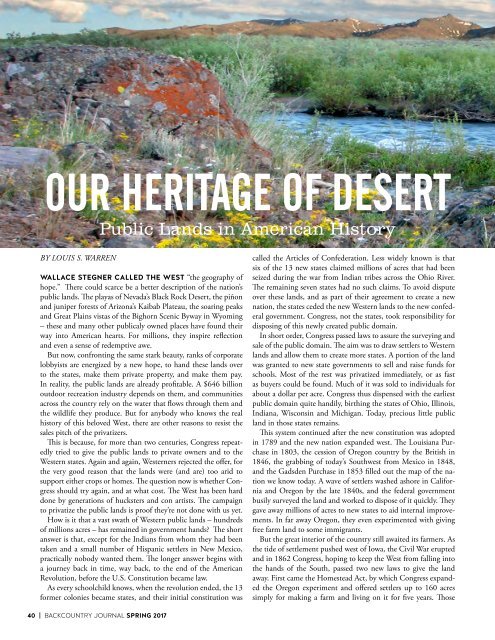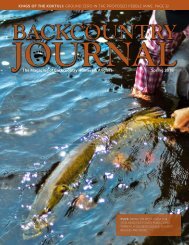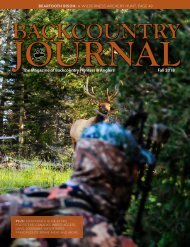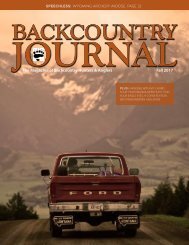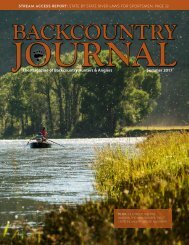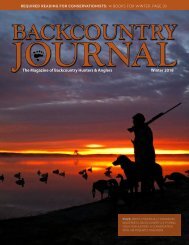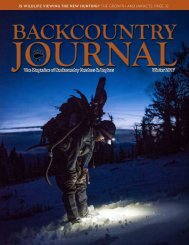BCJ_SPRING 17 Digital Edition
Create successful ePaper yourself
Turn your PDF publications into a flip-book with our unique Google optimized e-Paper software.
OUR HERITAGE OF DESERT<br />
Public Lands in American History<br />
Bryan Huskey photo<br />
BY LOUIS S. WARREN<br />
WALLACE STEGNER CALLED THE WEST “the geography of<br />
hope.” There could scarce be a better description of the nation’s<br />
public lands. The playas of Nevada’s Black Rock Desert, the piñon<br />
and juniper forests of Arizona’s Kaibab Plateau, the soaring peaks<br />
and Great Plains vistas of the Bighorn Scenic Byway in Wyoming<br />
– these and many other publicaly owned places have found their<br />
way into American hearts. For millions, they inspire reflection<br />
and even a sense of redemptive awe.<br />
But now, confronting the same stark beauty, ranks of corporate<br />
lobbyists are energized by a new hope, to hand these lands over<br />
to the states, make them private property, and make them pay.<br />
In reality, the public lands are already profitable. A $646 billion<br />
outdoor recreation industry depends on them, and communities<br />
across the country rely on the water that flows through them and<br />
the wildlife they produce. But for anybody who knows the real<br />
history of this beloved West, there are other reasons to resist the<br />
sales pitch of the privatizers.<br />
This is because, for more than two centuries, Congress repeatedly<br />
tried to give the public lands to private owners and to the<br />
Western states. Again and again, Westerners rejected the offer, for<br />
the very good reason that the lands were (and are) too arid to<br />
support either crops or homes. The question now is whether Congress<br />
should try again, and at what cost. The West has been hard<br />
done by generations of hucksters and con artists. The campaign<br />
to privatize the public lands is proof they’re not done with us yet.<br />
How is it that a vast swath of Western public lands – hundreds<br />
of millions acres – has remained in government hands? The short<br />
answer is that, except for the Indians from whom they had been<br />
taken and a small number of Hispanic settlers in New Mexico,<br />
practically nobody wanted them. The longer answer begins with<br />
a journey back in time, way back, to the end of the American<br />
Revolution, before the U.S. Constitution became law.<br />
As every schoolchild knows, when the revolution ended, the 13<br />
former colonies became states, and their initial constitution was<br />
called the Articles of Confederation. Less widely known is that<br />
six of the 13 new states claimed millions of acres that had been<br />
seized during the war from Indian tribes across the Ohio River.<br />
The remaining seven states had no such claims. To avoid dispute<br />
over these lands, and as part of their agreement to create a new<br />
nation, the states ceded the new Western lands to the new confederal<br />
government. Congress, not the states, took responsibility for<br />
disposing of this newly created public domain.<br />
In short order, Congress passed laws to assure the surveying and<br />
sale of the public domain. The aim was to draw settlers to Western<br />
lands and allow them to create more states. A portion of the land<br />
was granted to new state governments to sell and raise funds for<br />
schools. Most of the rest was privatized immediately, or as fast<br />
as buyers could be found. Much of it was sold to individuals for<br />
about a dollar per acre. Congress thus dispensed with the earliest<br />
public domain quite handily, birthing the states of Ohio, Illinois,<br />
Indiana, Wisconsin and Michigan. Today, precious little public<br />
land in those states remains.<br />
This system continued after the new constitution was adopted<br />
in <strong>17</strong>89 and the new nation expanded west. The Louisiana Purchase<br />
in 1803, the cession of Oregon country by the British in<br />
1846, the grabbing of today’s Southwest from Mexico in 1848,<br />
and the Gadsden Purchase in 1853 filled out the map of the nation<br />
we know today. A wave of settlers washed ashore in California<br />
and Oregon by the late 1840s, and the federal government<br />
busily surveyed the land and worked to dispose of it quickly. They<br />
gave away millions of acres to new states to aid internal improvements.<br />
In far away Oregon, they even experimented with giving<br />
free farm land to some immigrants.<br />
But the great interior of the country still awaited its farmers. As<br />
the tide of settlement pushed west of Iowa, the Civil War erupted<br />
and in 1862 Congress, hoping to keep the West from falling into<br />
the hands of the South, passed two new laws to give the land<br />
away. First came the Homestead Act, by which Congress expanded<br />
the Oregon experiment and offered settlers up to 160 acres<br />
simply for making a farm and living on it for five years. Those<br />
who did not want to wait to “prove up” could buy the land after<br />
six months, at $1.25 an acre.<br />
Second, Congress passed the Pacific Railway Act, which gave to<br />
the corporations building the new transcontinental railroads ten<br />
square miles of land for every mile of track they laid. Congress<br />
later doubled this generous subsidy and, before the railroad boom<br />
was over, an area bigger than California would pass to the railroad<br />
companies who mostly sold it to settlers and speculators.<br />
With so much cheap or even free land suddenly available,<br />
during the 1870s eager farmers swarmed into Nebraska, Kansas<br />
and the Dakotas. But the rush hit a headwind. Because of the rain<br />
shadow cast by the Rocky Mountains, precipitation diminishes<br />
markedly on the west side of the Hundredth Meridian. Most of<br />
this high Great Plains country– the western two-thirds of Kansas,<br />
Nebraska and the Dakotas, all of Wyoming and most of Colorado<br />
and Montana, was too cold and too dry to allow much farming.<br />
The arid Plains were not the only obstacles. Further west still,<br />
the mountains of the Sierra Nevada and the Cascades cast their<br />
own rain shadows. Nevada, Arizona, New Mexico and much of<br />
Idaho, Washington, Oregon, and even southern California were<br />
unrelentingly dry.<br />
When it came to dispensing with this thirsty public domain,<br />
Congress would act in ways visionary, desperate or craven – and<br />
sometimes all three. In 1872, they recognized a new value for<br />
the remote highlands and established Yellowstone National Park,<br />
beginning a tradition of reserving scenic wonders for public enjoyment.<br />
But that same year, they began to up the ante on the great giveaway.<br />
They offered land for five dollars an acre to anybody who<br />
staked a valid mining claim on it. The next year, in 1873, they<br />
offered any homesteader a second 160-acre parcel in return for<br />
planting trees on it, in hopes that trees would bring rain. (They<br />
did not; the trees mostly died.) They began to enlarge maximum<br />
homestead claims in hopes of compensating for the land’s aridity.<br />
By 1909, they had doubled the old 160 acre homesteading limit<br />
to 320 acres, and in some places to 640 acres.<br />
At the same time, Congress reserved other lands in hopes of<br />
better sustaining Western settlements. Recognizing that farms<br />
and cities on the dry lowlands depended on rivers fed by mountain<br />
snow, and that those rivers could erode and fill with sediment<br />
if their banks were ploughed, overgrazed or overcut, Congress<br />
in 1891 passed a law allowing the creation of “forest reserves”<br />
– soon to be called national forests. These high elevation stands<br />
of trees under federal management would protect Western rivers<br />
and streams.<br />
Putting those rivers to use, Congress set out to water the desert<br />
they had been unable to give away, with dams and irrigation<br />
works funded by the National Reclamation Act of 1902. Soon<br />
they were offering “reclamation homesteads” on these projects,<br />
and under this and other, expanded versions of the old homestead<br />
law, more land was claimed in homesteads after 1900 than before.<br />
But the growth of private land ownership finally stalled. The<br />
1920s saw a ferocious Western drought coincide with a global<br />
glut of grain. Farms and ranches that barely got enough rain in<br />
good years now turned to dust, while market prices for their produce<br />
plummeted. Many settlers simply abandoned their homestead<br />
claims without proving up, and the land reverted to federal<br />
ownership. In the end, homesteaders would take 269 million<br />
acres from the public lands. But by 1930, they had rejected an<br />
area almost as large, 200 million acres, as too high or dry. These<br />
lands remained unclaimed by private owners or any government<br />
agency.<br />
Eager to cut federal expenses, President Herbert Hoover tried<br />
to give to the states some of the remaining public lands. But the<br />
states refused them. As George H. Dern, governor of Utah from<br />
1925 to 1933, explained, the states already owned millions of<br />
acres “of this same kind of land, which they can neither sell nor<br />
lease, and which is yielding no income. Why should they want<br />
more of this precious heritage of desert?”<br />
As that dismal decade wore on and Plains states choked on<br />
the fatal storms of the Dust Bowl, it became clear that farming<br />
the arid lands had been a disaster. Western state governors, beset<br />
40 | BACKCOUNTRY JOURNAL <strong>SPRING</strong> 20<strong>17</strong><br />
<strong>SPRING</strong> 20<strong>17</strong> BACKCOUNTRY JOURNAL | 41


